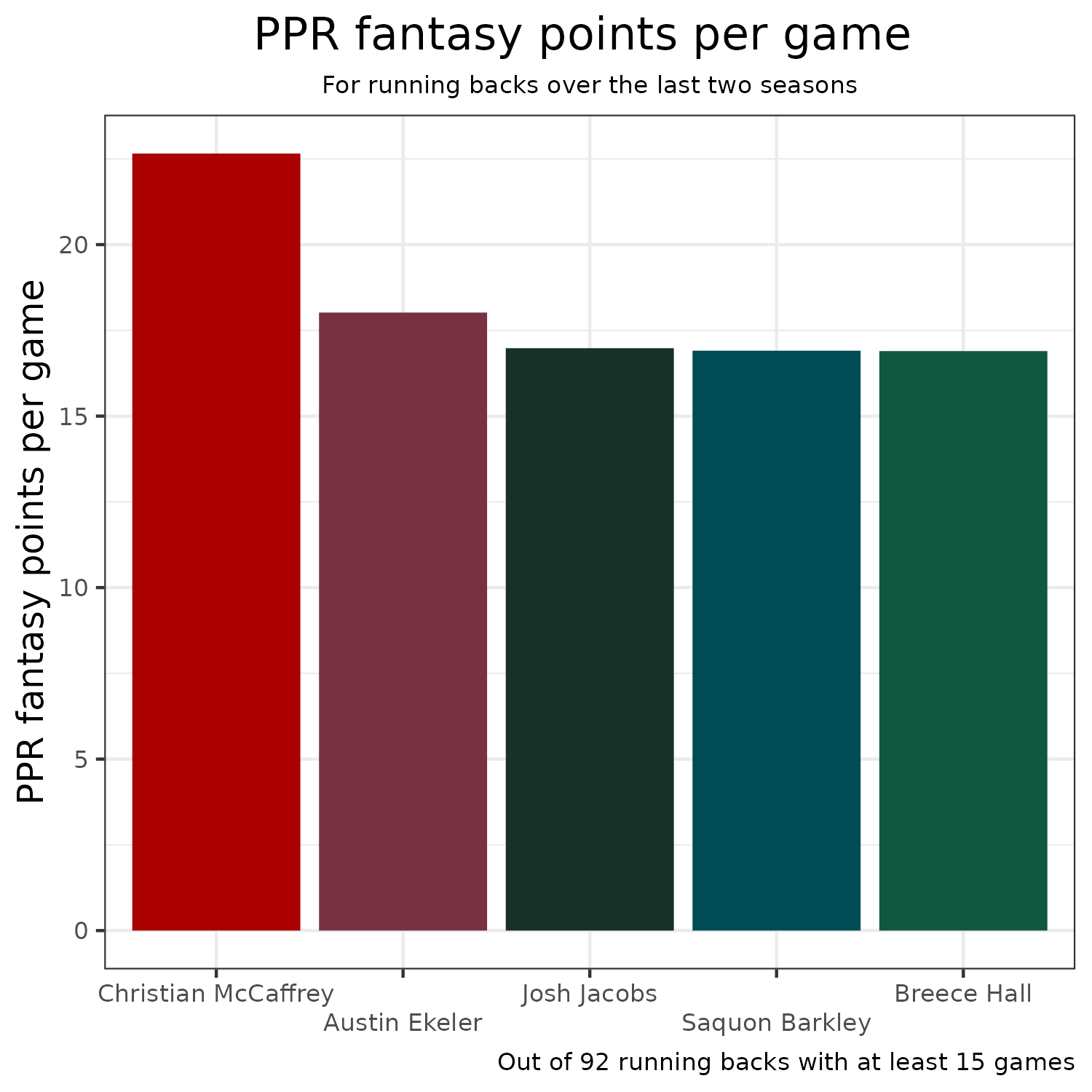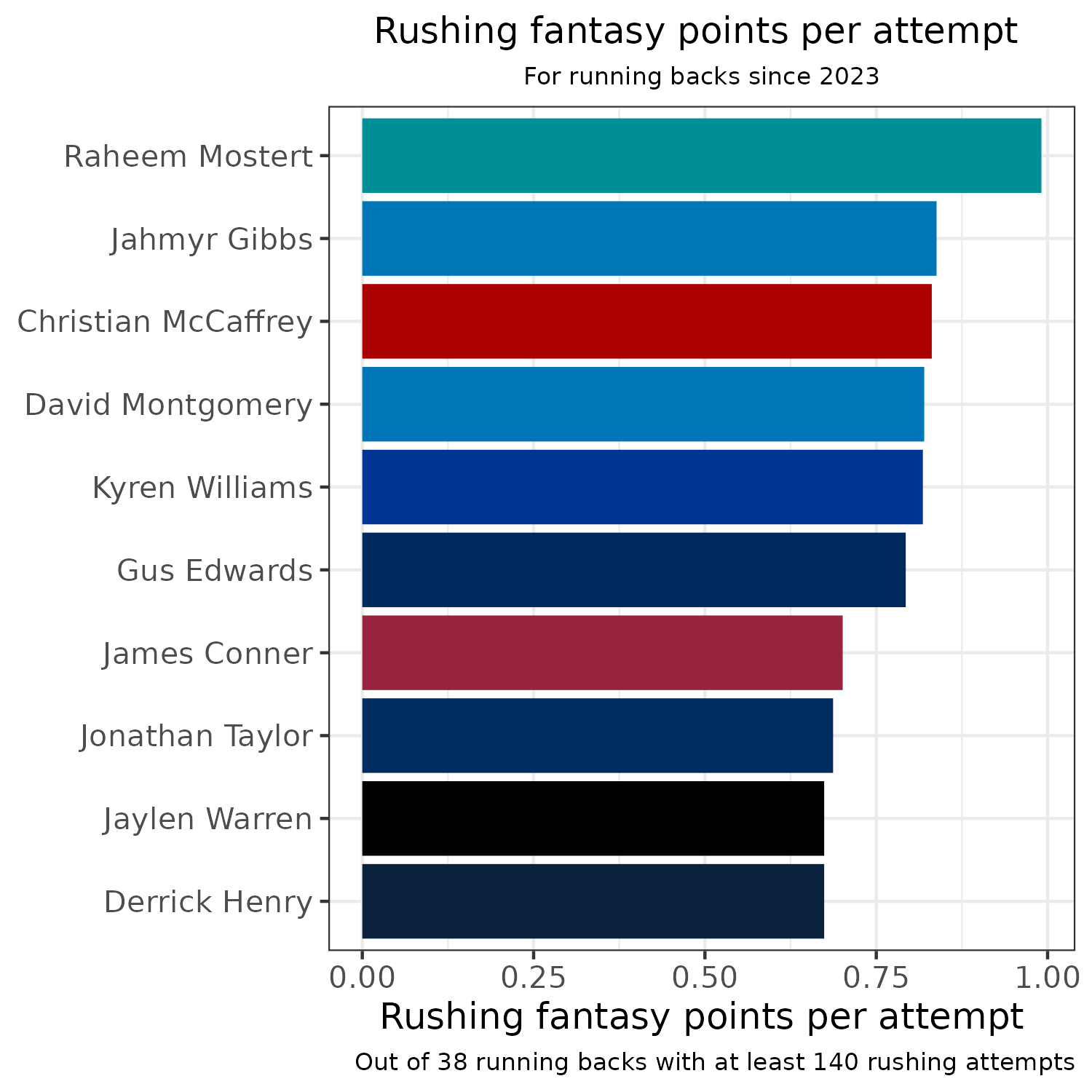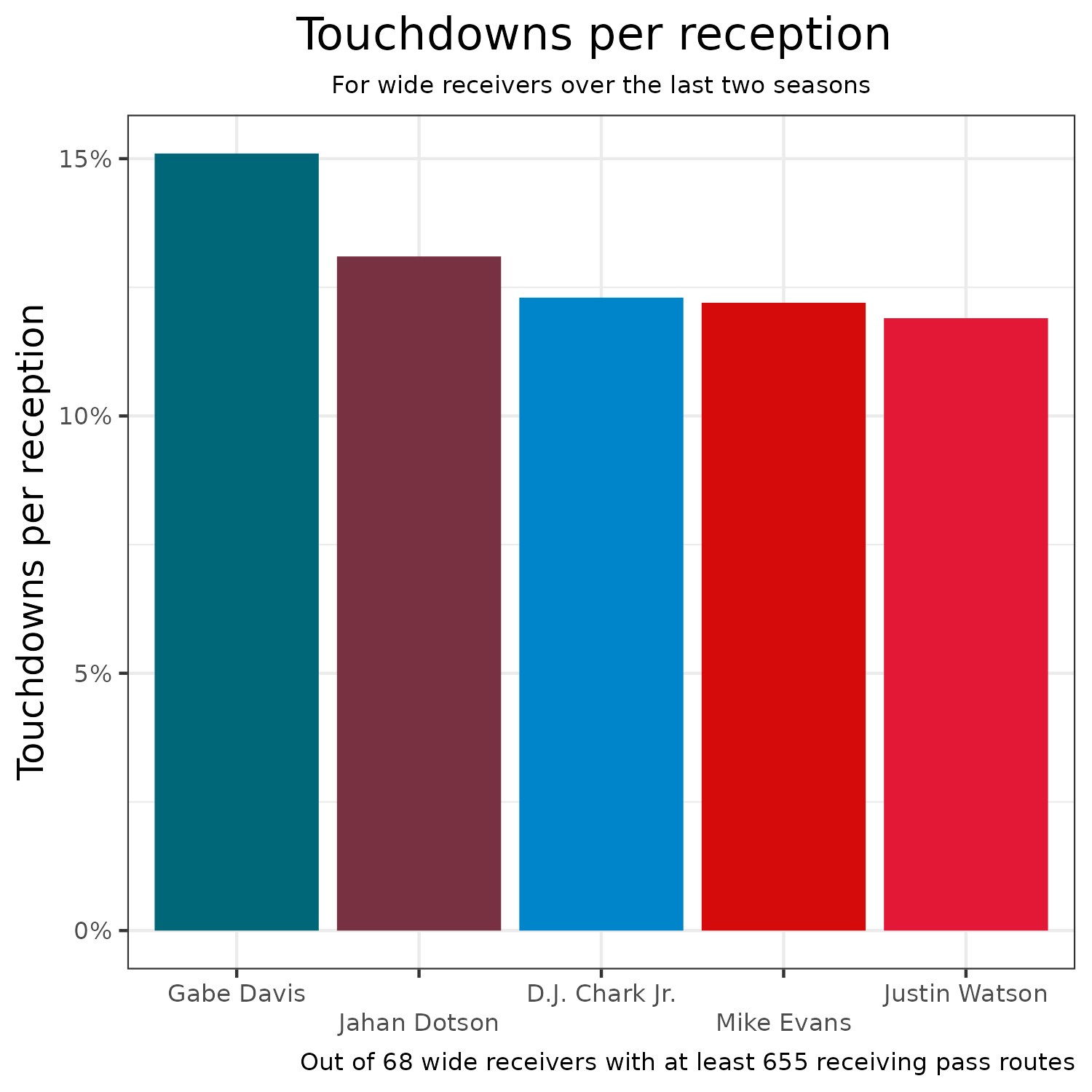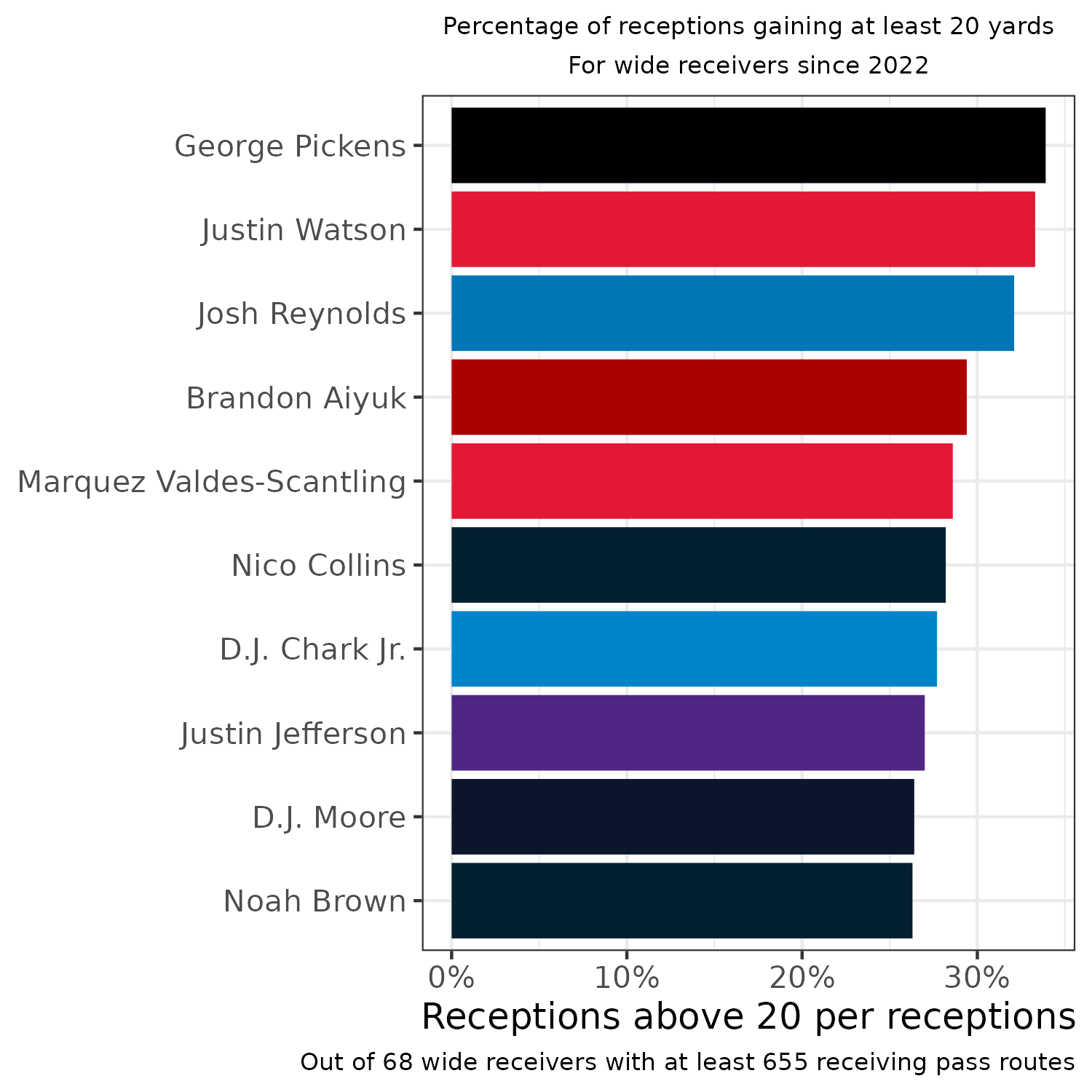• Josh Jacobs and Saquon Barkley improve their situations: Both running backs go from a team where defenses were focused on stopping them to more well-rounded teams where they can thrive.
• Several running backs gain unwanted competition: Players like Rhamondre Stevenson, Tyjae Spears and Khalil Herbert all gained significant competition from free agent signings.
• Draft and trade for yourself: Try PFF's Mock Draft Simulator — trade picks and players and mock for your favorite NFL team.
Estimated Reading Time: 12 mins
Click here for more draft tools:
2024 Mock Draft Simulator | 2024 Big Board | 2024 Draft Guide
2024 Player Profiles | 2024 Mock Drafts | NCAA Premium Stats
The five winners and five losers from the start of free agency look at 10 players who have seen their fantasy value increase or decrease based on player movement over the last few days. The focus is on players who have changed teams and how it impacts those players and their teammates.
Winners
WR Drake London and TE Kyle Pitts, Atlanta Falcons
- London and Pitts were both top-10 draft picks in the NFL draft, but neither player has lived up to expectations in terms of fantasy production to this point.
- London finished as WR36 last season despite being Atlanta's clear top wide receiver while Pitts was TE13 despite top-five expectations heading into the season.
- A big problem for both players was the number of passes thrown their way that were uncatchable.
- Desmond Ridder and Taylor Heinicke rank among the top 13 quarterbacks in uncatchable inaccurate pass percentage beyond the line of scrimmage over the last two seasons among 61 quarterbacks.
- Will Levis and potentially Justin Fields are the only quarterbacks in the bottom 13 expected to be starters.
- Their new quarterback, Kirk Cousins, has the fourth-lowest rate.
- The receivers will also benefit from a more pass-happy offense. The Falcons were the most run-heavy team over the last two seasons.
- New offensive coordinator Zac Robinson comes from the Los Angeles Rams, who have been right at league average over the last two years.
- More high-quality passes should help both receivers reach their full potential.
- While this helps the Falcons receivers, it similarly hurts the Minnesota Vikings receivers.

RB Josh Jacobs, Green Bay Packers
- Jacobs has been one of the most successful running backs over the last three seasons with a league-leading 175 avoided tackles.
- Jacobs plays better against a lighter box, which is true for all running backs, but it’s been especially true for Jacobs.
- He’s averaged 2.9 yards per carry against an eight-man box over the last three seasons, which is second-worst among 33 qualifying running backs. He averages 4.9 yards against a seven-man box or less, which ranks ninth.
- Similarly, he has the eighth-worst PFF run grade against an eight-man box and second-best among a light box.
- The Packers used to be a top-five team in terms of carries against light-boxes. That fell last season due to the switch to Jordan Love at quarterback but as the season progressed, Love and the passing game improved, leading to more light boxes again.
- Green Bay will likely add another running back because they need to replace both Aaron Jones and A.J. Dillon, and Jacobs shouldn’t be expected to play over 90% of Green Bay's offensive snaps. As long as the second option isn’t too strong, Jacobs should be a top-10 fantasy running back this year.
RB Saquon Barkley, Philadelphia Eagles
- Barkley is another star running back who is going to a better situation.
- For Barkley, the big difference will be the offensive line. New York Giants running backs were stuffed in the backfield on 23.3% of runs last season, which was second-worst, while Eagles running backs were stuffed on 14.2%, which was second-best.
- This led Eagles backs to see more than double the yards before contact per attempt from 0.9 to 1.9.
- Barkley averaged 6.6 yards per carry last season when he saw at least one yard before contact, which ranked 10th best among running backs.
- The only concern is the tush push. The Eagles only ran once with a running back when they were within two yards of scoring, which was tied for the fewest, but 14 times with Jalen Hurts, which was by far the most.
- The Giants only ran four times with a running back within two yards of scoring last season, so there shouldn’t be a huge difference in touchdown production.
- If anything, the loss of center Jason Kelce to retirement might hurt the overall offensive production of the team, but it might also lead to fewer quarterback sneaks and more Barkley touchdowns.

RB Gus Edwards, Los Angeles Chargers
- Edwards has a career 4.9 yards per carry but was constantly a backup option in Baltimore, either behind Mark Ingram II or J.K. Dobbins.
- He’s constantly played with Lamar Jackson, which has also hurt his potential rushing attempts.
- He’s only exceeded 16 carries in a game once in the last four seasons.
- In Los Angeles, he could have the opportunity to be the lead back due to Austin Ekeler signing with the Washington Commanders and little competition remaining on the roster.
- The Chargers had the worst PFF run-block grade for a team last season, but Edwards has generally made the best in bad situations before. He averages 2.2 yards per carry in his career when first contacted at or behind the line of scrimmage. Nick Chubb is the only running back better in that time at 2.4.
- The Ravens have also faced the third-most eight-man boxes during Edwards’ career, but he should face a lot less with Justin Herbert at quarterback.
- Edwards averages 5.6 yards per carry in his career against a seven-man box or less, ranking sixth-best.
- In Los Angeles, he joins Jim Harbaugh, who ran the ball on 45.9% of plays during his time with the San Francisco 49ers, which was second-most during that time.
- He also joins Greg Roman, who was Edwards’ offensive coordinator or assistant head coach every season except this past one, which was also Edwards’ only season under 5.0 yards per carry.
- At this point in Edwards’ career with a lack of fantasy production in the past, we shouldn’t expect an excellent season out of him, but this could be the best situation for Edwards to stay fantasy-relevant.

WR Gabe Davis, Jacksonville Jaguars
- Davis joins Jacksonville as Calvin Ridley‘s presumed replacement.
- He was wildly inconsistent for fantasy football purposes thanks to a 14.1% target rate. That was the fifth-lowest among 36 wide receivers with at least 500 routes last season.
- Despite the low target rate, he still managed 22 explosive receptions, which ranked 26th among wide receivers.
- Davis had five games last season with at least 85 yards and a touchdown but also registered five games where he was held without a catch.
- While Christian Kirk and Evan Engram should still dominate targets in the middle of the field, Davis should be the best outside threat.
- Ridley finished at WR18 in that role last season. Davis probably won’t reach those same heights, but he should see a big enough increase in targets to stay in fantasy starting lineups with the no-catch headaches of last season.
- There is still at least a chance Ridley returns to the Jaguards or they make another significant move at wide receiver, which would greatly reduce Davis' fantasy value.

Losers
RB Tony Pollard and Tyjae Spears, Tennessee Titans
- Pollard and Spears are two of the more talented running backs in the NFL and ideally, both would be in a situation where they are the clear best runner on their team.
- Pollard totaled 836 offensive snaps last season, which was third-most among running backs. That was partially due to his talent but also partially due to a lack of competition with the Dallas Cowboys.
- His production generally declined as the Cowboys lead back, but a lot of that was due to the injury he suffered in the 2022-23 playoffs.
- Pollard said he felt better starting in Week 11. From Week 11 to the end of the season, he earned a 90.8 PFF rushing grade, which was the best among running backs.
- While he should play well, he will play fewer snaps with Spears as his competition.
- Pollard might also be less productive without Tyler Smith and Zack Martin leading the way on his runs.
- Spears seemed to be in a good position to be the starter this season with Derrick Henry leaving, but he will be stuck in a backup role.
- Spears will ideally get more opportunities to run the ball, but he also probably won’t be on the field as much in passing situations.
- This makes it unlikely Spears can be in fantasy starting lineups unless there is an injury to Pollard.
RB Khalil Herbert and Roschon Johnson, Chicago Bears
- The Bears had one of the better rushing attacks last season, averaging 4.3 yards per carry from their running backs, tied for ninth among teams.
- The running backs on the team have a solid 83.0 PFF team rushing grade, but the blocking was below average with a team 55.1 PFF run-block grade, ranking ninth-worst among teams.
- Chicago made the first big splash of the tampering period by adding D’Andre Swift to presumably be the team’s new starter.
- Herbert and Johnson would have both ranked among the top 36 running backs heading into the season had Chicago not made a change at running back, but the Swift addition pushes both much further down the fantasy rankings.
- They are both late-round targets in case Swift suffers an injury, and even then, we don’t know how snaps will be distributed between the two in new offensive coordinator Shane Waldron’s offense.
- Swift should have decent fantasy value assuming he is playing at least 65% of his team's offensive snaps. He will be running behind a worse offensive line compared to Philadelphia, but he should have more opportunities to score touchdowns.
- Swift only ran once out of a possible 15 run plays when the Eagles were within two yards of scoring. He should see most of the short-yardage carries in Chicago.
RB Rhamondre Stevenson, New England Patriots
- Stevenson struggled to live up to expectations last season with just 12.1 PPR points per game, 28th among running backs.
- There was some hope Stevenson would have a better 2024 season with Alex Van Pelt as his offensive coordinator and a new quarterback to lead the offense.
- Stevenson said a month ago he wants to be the feature back after splitting time with Ezekiel Elliott last season and Damien Harris before that. Unfortunately for Stevenson, he will be sharing the backfield with Antonio Gibson.
- Gibson has a 76.7 PFF receiving grade over the last two seasons, which ranks seventh among running backs with at least 200 routes. Stevenson had a 60.8 PFF grade, ranking 34th-best.
- Stevenson had looked good compared to Elliott (54.6) and Harris (55.3), but Gibson is likely to be the third-down back over Stevenson as well as the primary backup.
- Stevenson will still have some fantasy value particularly if Gibson suffers an injury, but given the Patriots’ offense and the likely split, Stevenson will probably be on fantasy benches more often than not.

QB Justin Fields, Chicago Bears
- Signs have pointed to Chicago taking a quarterback with the first-overall pick, which seemed to make Fields’ days with the Bears numbered.
- As of less than a week ago, the two teams with the best odds to add Fields were the Atlanta Falcons and Pittsburgh Steelers. Those two teams added Kirk Cousins and Russell Wilson, presumably putting them out of the running.
- The Las Vegas Raiders were also among the top-five landing spots, but they added Gardner Minshew. That doesn’t mean the Raiders are 100% out on Fields but makes their chances a lot less likely. Similarly, the New England Patriots signed Jacoby Brissett, making it less likely Fields ends up a Patriot.
- This leaves the Minnesota Vikings as Fields’ best shot at a starting job after they lost Cousins in free agency and don’t have a clear replacement on the roster if the Bears are willing to trade within the division.
- The Denver Broncos and New York Giants are the other possibilities for Fields to get traded and be a starter, but those teams lack the same receiving options as the Falcons, Steelers, or even the Bears with D.J. Moore.
- After the last few days, the odds of him landing with a great wide receiver have decreased while the odds of him staying in Chicago as a backup have increased.
WR George Pickens, Pittsburgh Steelers
- Pickens has been one of the best deep-threat wide receivers in the NFL since getting drafted by the Steelers.
- His 27 deep receptions rank fifth-best among wide receivers over the last two seasons while his 864 receiving yards on deep passes rank seventh-best.
- Pittsburgh made a change at quarterback with the Russell Wilson addition, which moves Kenny Pickett to the bench.
- Wilson has been the better player of the two on short and intermediate passes with a 67.3% accuracy percentage compared to Pickett's 60.0% over the last two seasons.
- However, Wilson hasn’t been the deep ball thrower he once was earlier in his career. His accuracy on deep passes drops to 40.0% while Pickett’s accuracy rate is at 49.3% on deep passes.
- Similarly, Wilson has graded better than Pickett on short and intermediate passes while Pickett has graded better than Wilson on deep throws.
- Pickett threw to his first read on 69% of his passes over the last two years while Wilson was at 60%. Wilson was more likely to check down to a running back.
- Pickens has a 21.3% target rate on plays where the ball is thrown to the first read compared to a 10.2% rate when the ball isn’t thrown to the first read.
- The Wilson addition should help the offense as a whole, but might not have the same positive impact on Pickens.





 © 2025 PFF - all rights reserved.
© 2025 PFF - all rights reserved.